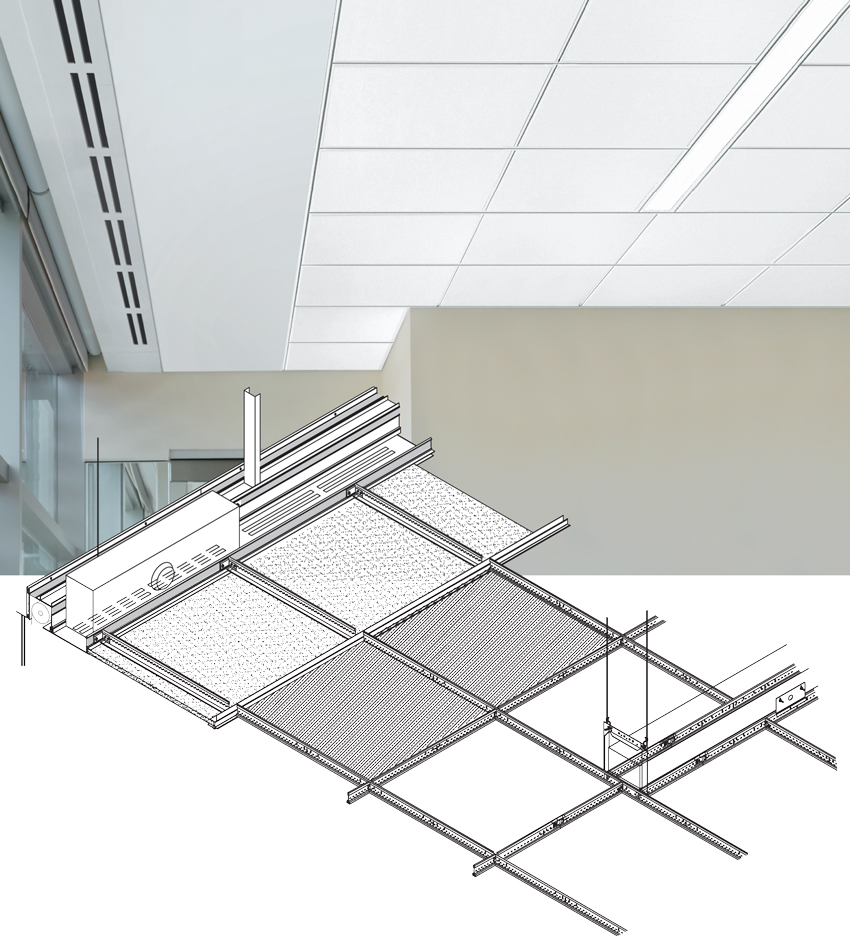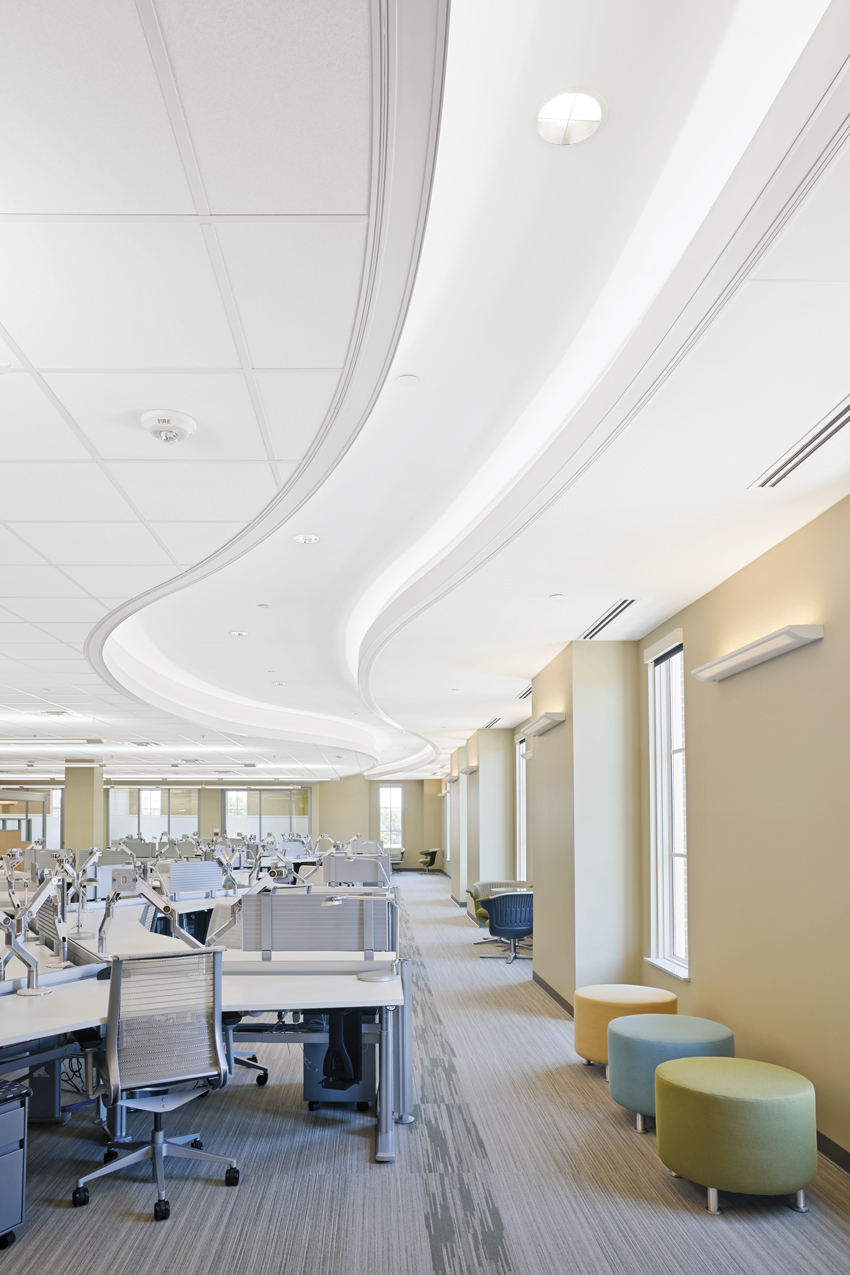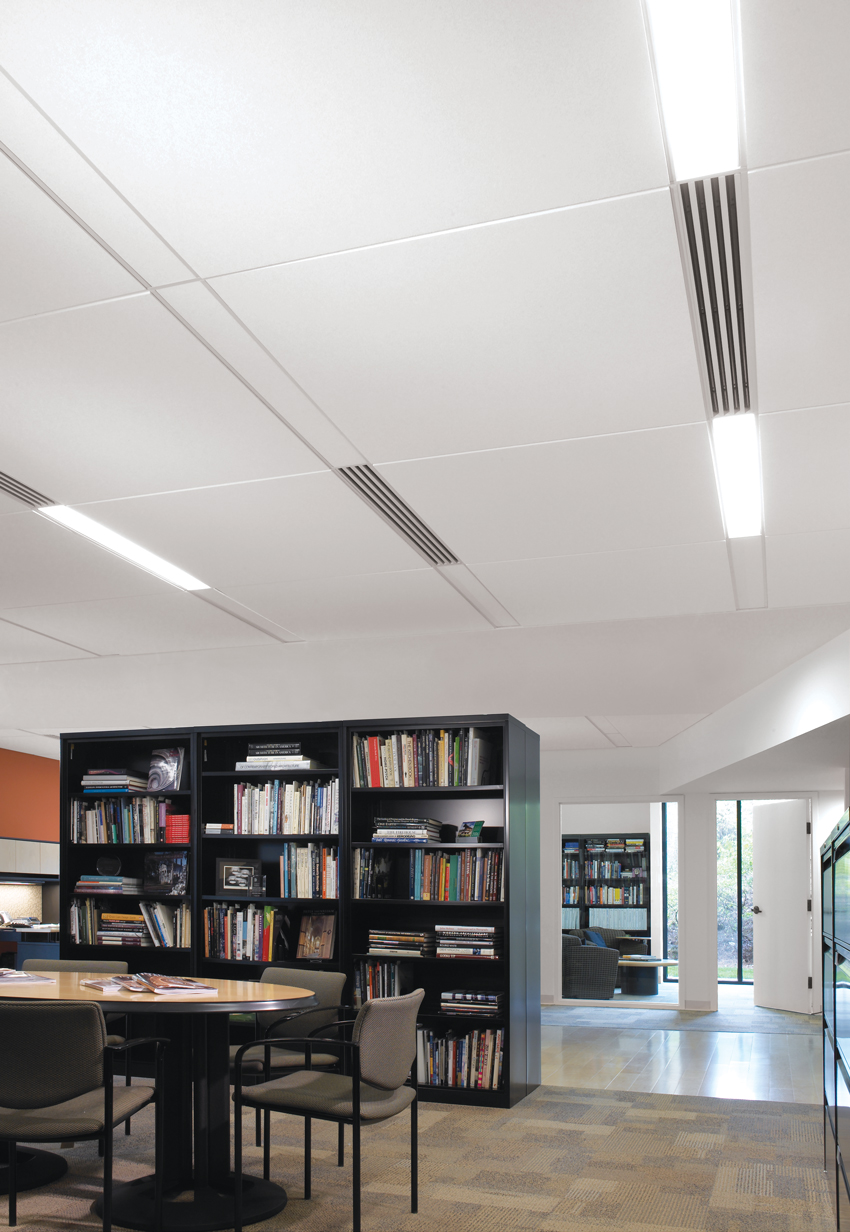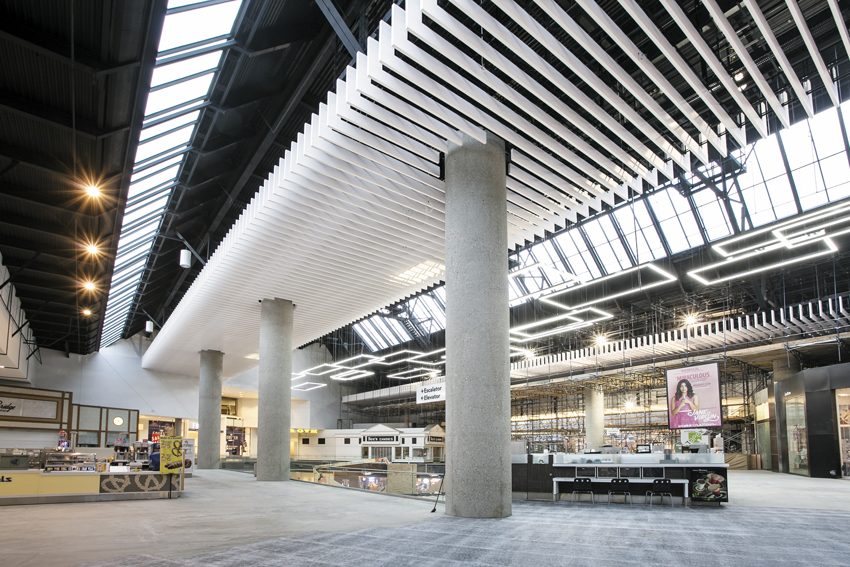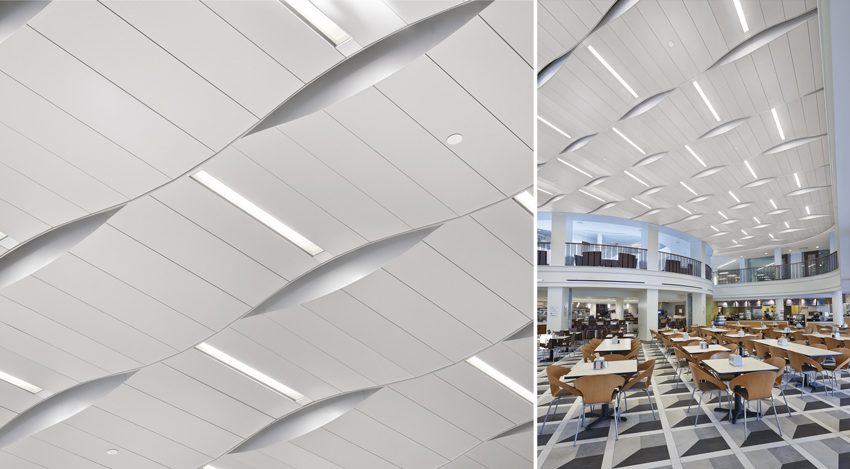Understanding Code-Compliant Integrated Ceiling Solutions
Using modern ceiling installation systems to meet design intent, IBC code requirements, and construction schedules
![]() Continuing Education
Continuing Education
Use the following learning objectives to focus your study while reading this month’s Continuing Education article.
Learning Objectives - After reading this article, you will be able to:
- Discuss new installation systems that navigate the challenges of designing ceilings from one end of a building to another.
- Explain the design and construction benefits of pre-engineered integrated ceiling systems versus traditional ceiling design and construction practices.
- Describe the environmental and occupant comfort benefits of pre-engineered systems versus traditional systems.
- Apply new construction practice knowledge to make informed product specification choices.
- Implement new construction methods to design ceilings that can be easily constructed.
New solutions are available that make building high-performance, aesthetically pleasing, integrated ceilings faster and easier than ever before. Traditional ceiling construction methods are less and less compatible with current design trends, expedited construction schedules, and sustainability practices. You are challenged with designing spaces that that meet your clients’ design intent and IBC and ASTM requirements, while contractors are pushed to meet accelerated construction schedules. By collaborating early with your ceiling partner, you can ensure best practices are followed for your project to meet design intent.
Pre-Engineered Ceiling Construction
Pre-engineered ceiling components were used in the Bell Helicopter headquarters construction to reduce coordination between trades, labor costs, and to speed the construction schedule. The ceiling components met the same codes and standards as traditionally built, on-site systems and reflected the identical design intent and specifications of the most sophisticated site-built systems using the same architect-specified materials. Thirty to 50 percent faster to build and install compared to traditionally constructed ceilings, they generate less waste, provide consistent quality throughout the building, and meet tighter construction schedules.
Pre-engineered components and related details can be included in specifications to ensure consistent installed visuals throughout a project. Pre-engineered ceiling systems are often already tested and approved for use in Seismic DEF building areas, backed by the required certifications available from the manufacturer. If you are specifying for a LEED project, components can contribute to credits.
In addition to traditional ceiling systems, examples of pre-engineered ceiling system solutions include: drywall suspension systems for ceilings and soffits, light coves, shade pockets, transitions, and acoustical clouds and canopies.
Design Details: Pre-Engineered Trims and Transitions
Pre-engineered trim and transition options can be used to address changes in elevation, geometry, or material type. Transitions are available that make acoustical panels to drywall, as well as geometric shifts, such as from a rectangular office to a curved hallway, fast and easy to detail and build. Pre-engineered transitions eliminate excess framing, provide consistent fit and finish, and allow for quality control, while reducing the time required detailing and specifying. These transition solutions are designed precisely to fit with a variety of ceiling panel types and suspension systems. Unique curves and shapes as well as crisp detailing are easily duplicated throughout an entire project. Pre-engineered steel and extruded aluminum transitions use significantly less framing to structure and eliminate interferences in the plenum that can reduce the construction schedule, minimizing risk and ensuring design intent. These transitions are often tested to meet the same codes as standard transitions, including seismic requirements, and are available in a wide variety of standard and custom colors.
Design Details: Integrated Shade Pockets for Acoustical and Drywall Ceilings
Traditionally, ceilings (either acoustical or drywall), shade pockets, and shades require coordination between multiple trades, potentially leading to lengthier construction schedules and poor fit and finish. Pre-engineered extruded aluminum pocket and shade options provide seamless integration between a variety of acoustical and drywall ceiling types, making specification simpler and installation faster and easier, while eliminating additional trade coordination and reducing ceiling construction schedules by 50 percent or more. Pre-engineered shade pocket options also allow consistent quality control at the building perimeter, reducing time required to detail and specify. They can also be customized in depth and dimension to work with almost any popular shade option you might choose.
Design Details: Monolithic Ceiling Design
Traditional suspended ceiling systems are often riddled with lighting, HVAC, sprinklers, and other visual “nose” break points, disrupting the appearance of the ceiling plane and the design of the space. Integrated ceiling solutions offer the ability to organize layouts to reduce visual clutter and integrate lighting, air diffusers, and other accessories, such as sprinkler systems into “zones” as narrow as 4 inches wide.

Photo courtesy of Armstrong Commercial Ceiling Solutions
Ceiling system with compact linear zones for light fixtures
Some ceiling manufacturers prequalify lighting fixtures from partner companies for fit and finish. This option makes designing and installing a customized, integrated ceiling and lighting layout using standard ceiling panels and suspension systems faster and easier.
Integrating linear lighting fixtures in a symmetrical, on-center continuous, or non-continuous layout can also be done using factory-finished or made-to-order ceiling panels and suspension systems. Wall-to-wall and cloud or canopy LED light fixtures can now be easily installed without independent suspension, and comply with IBC Seismic Design Categories (SDCs) D, E, and F for areas with high or very high seismic vulnerability.
There are six SDCs ranging from A to F. Structures posing minimal seismic risk are assigned as an SDC A, and structures posing the highest seismic risk are assigned an SDC F category. As a structure’s potential seismic risk increases, as represented by the Seismic Design Category, the NEHRP Recommended Seismic Provisions requires progressively more rigorous seismic design and construction as a means of attempting to ensure that all buildings provide an acceptable risk to the public. According to the National Institute of Building Sciences (NIBS), structures are assigned to a Seismic Design Category based on the severity of ground shaking and other earthquake effects the structure may experience and the nature of the structure’s occupancy and use.
Design Details: Lighting Integration
Lighting integrated within a ceiling’s suspension system offers the benefits of code compliance, easy installation, and plug-and-play capability needed for today’s flexible spaces. Ceiling manufacturer suspension systems specifically designed for integration with lighting, reduce trade coordination and labor requirements. Lighting fixtures can even install from below into the ceiling suspension system, eliminating construction coordination hassles, while reducing required plenum depth.
For example, pre-engineered extruded aluminum light coves for direct and indirect applications can integrate with acoustical or drywall ceiling suspension systems even in low plenum clearance areas and provide predictable lighting performance with a variety of prequalified lighting partners. Installation time and labor are reduced up to 50 percent. Working with the ceiling manufacturer early in the process as the lighting plan is considered ensures details are per your specifications and are not solved for on the jobsite.
Pre-engineered lighting options include:
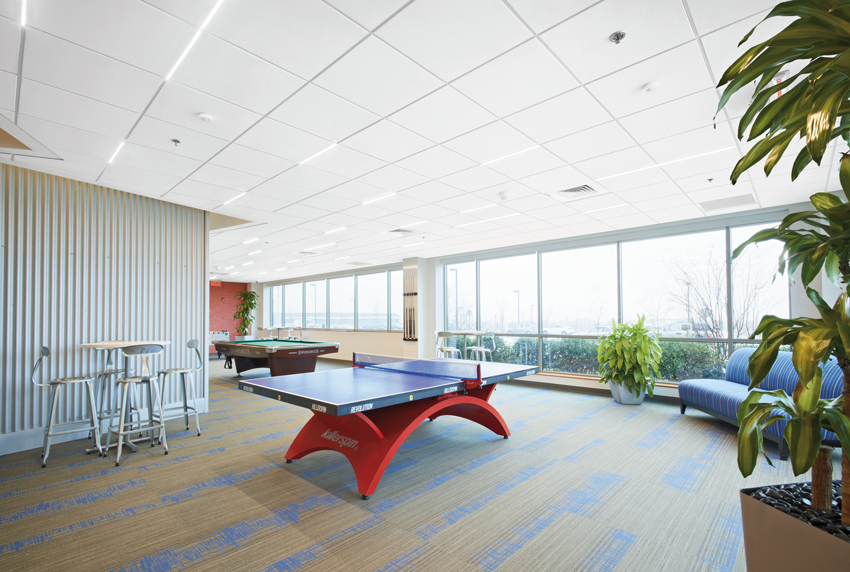
Photo courtesy of Armstrong Commercial Ceiling Solutions
T-bar suspension system lighting: zero plenum lighting fixtures install like a standard cross tee for increased ceiling heights and minimal plenum interference.
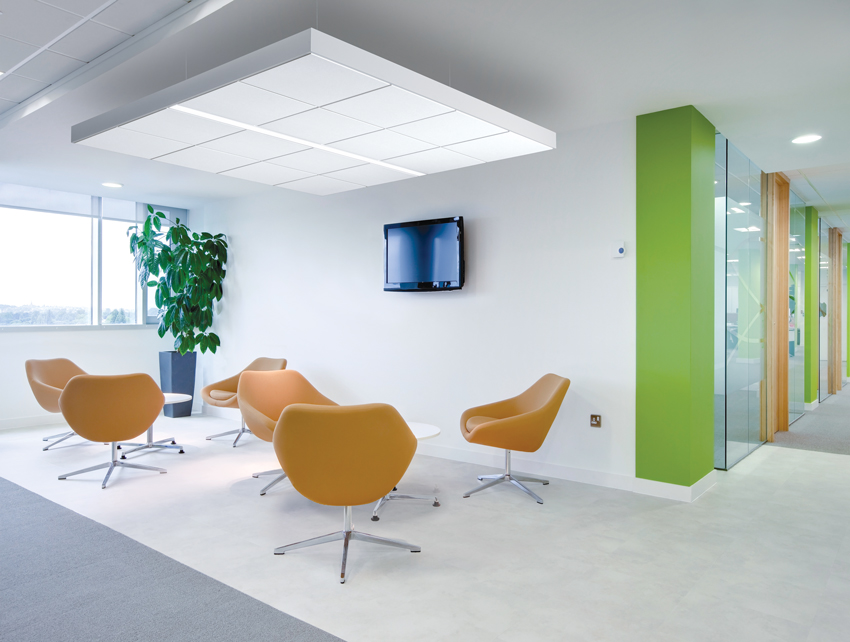
Photo courtesy of Armstrong Commercial Ceiling Solutions
Acoustical cloud lighting: custom-look acoustical clouds with integrated lighting are packaged in easy-to-specify kits. These options provide outstanding performance for collaborative and focus areas in open plenum environments.

Photo courtesy of Armstrong Commercial Ceiling Solutions
On-center linear lighting: acoustical suspension systems provide lighting layout symmetry options using standard components to compliment your building design.
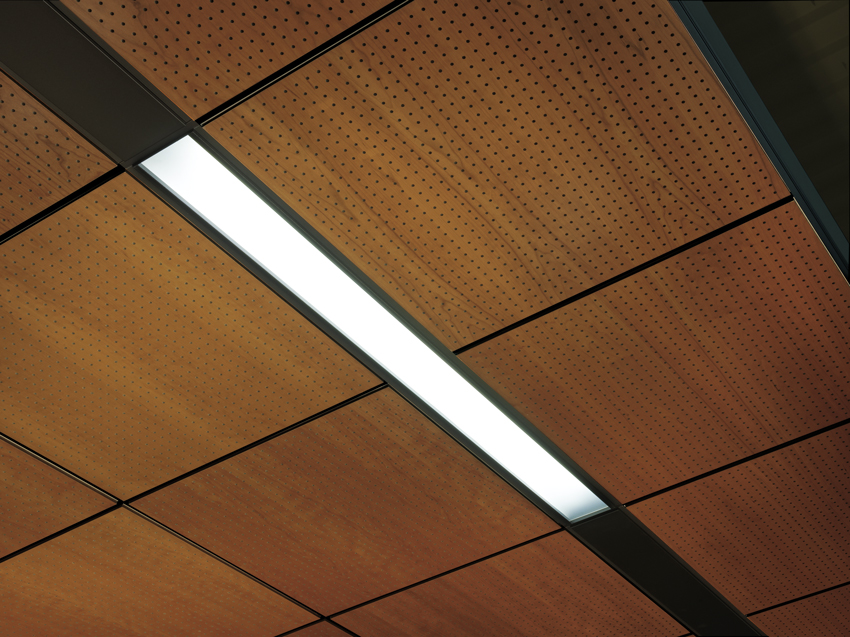
Photo courtesy of Armstrong Commercial Ceiling Solutions
Technical zone lighting: effectively integrate all technical services for an organized, simplified, monolithic ceiling visual, including lighting, diffusers, and sprinklers in metal, wood, and acoustical ceilings.
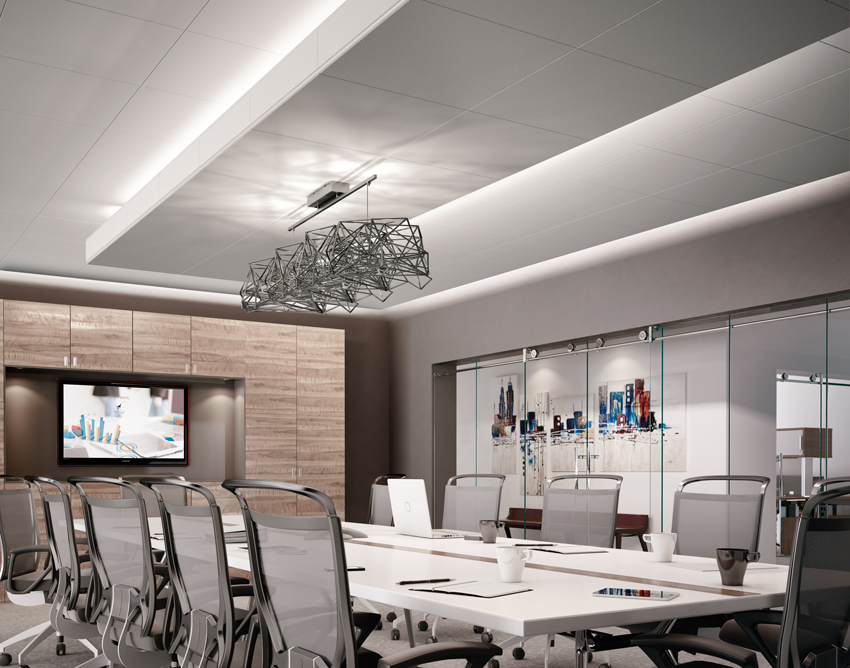
Photo courtesy of Armstrong Commercial Ceiling Solutions
Direct and indirect cove lighting: pre-engineered extruded aluminum light coves with integrated light fixtures provide predictable lighting performance.
Design Details: Acoustics in Flexible Building Design
Increased building flexibility and adaptive reuse over the life of a structure are not only hallmarks of modern design, they are sustainable strategies. While traditional design practices focused on development, commercial buildings focused on developing nonintrusive, moderate distraction zones and confidential spaces, today’s flexible designs think of end users of spaces based on needs of today’s workers: focus, collaboration, and confidentiality. Demountable partitions, open offices, and the ability to expand and contract footprints as needed lend flexibility but can severely complicate a designer’s job to match the best-performing ceiling panels to the changing clients needs.
Nowhere is this more true than in the ability to meet the acoustical needs within this new design approach. Today’s flexible spaces call for the ability to concentrate one minute and to collaborate the next.
The Gensler 2013 U.S. Workplace Survey showed that excessive noise at the office reduces worker effectiveness, raises stress, and lowers employee satisfaction, as verified by the Center for the Built Environment.
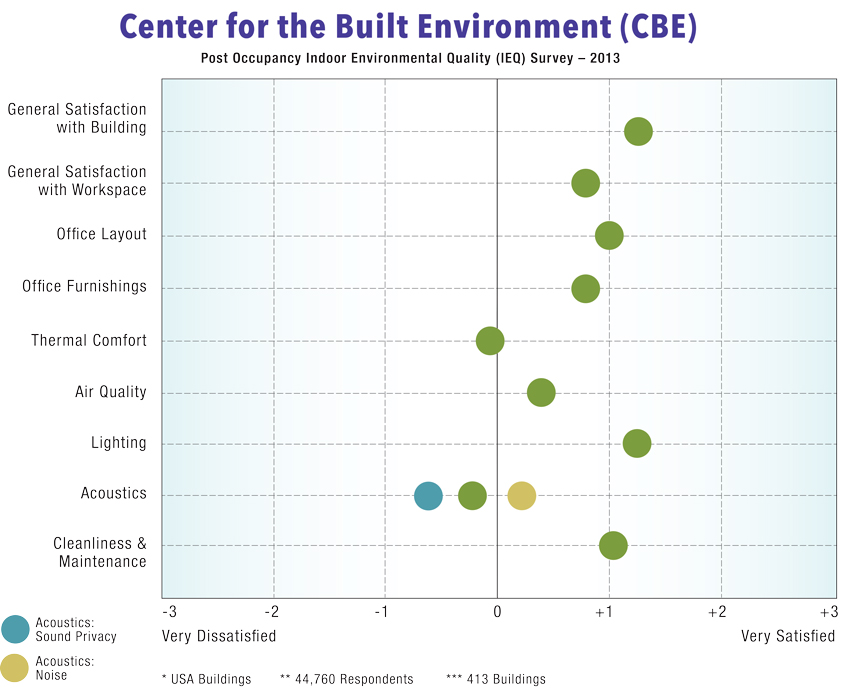
Image: Jensen, K., and E. Arens, 2004. Acoustic Quality in Office Workstations, as Assessed by Occupant Surveys. Proceedings, Indoor Air 2005, Sept. 4–9, Beijing, China.
Today’s open-plan areas can become tomorrow’s closed-plan areas, making both absorption (NRC) and blocking (CAC) important for not only current, but also future space flexibility. Understanding how to design for acoustics in today’s flexible interiors takes on new importance because traditional acoustical recommendations are not always compatible with today’s performance requirements.
Acoustic comfort means an acoustic environment that provides:
• speech intelligibility for clear communications and safety;
• speech privacy for confidentiality;
• low distractions and annoyance for a nonintrusive work space.
Advances in ceiling panel technology allow one ceiling panel to be installed across all spaces to provide both high sound absorption and sound blocking. Ceiling panels featuring a more comprehensive acoustics performance, offering the ideal combination of both sound absorption (NRC greater than 0.60) and sound blocking (CAC of 35 or greater). Installing a single ceiling panel with performance that controls both types of auditory distractions results in increased use flexibility and increased occupant comfort.
Standard Product Capabilities Enable Unique Looks on Tighter Budgets
When your design calls for a signature space with a custom look, but your budget is tight, many standard capabilities are available from ceiling providers to help you achieve a unique design. In the Harrah’s case study, standard 4-foot by 4-foot hexagons panels were used to represent the branches, supplemented by special sizes and shapes of panels for the trunk and transition to the canopy. This could have been done in a specific color, coordinated with other interior furnishings, or been taller plank-like panels. So, from a nonstandard panel size or shape to a special color, veneer, or perforation, many options are available to help you meet both your budget and design goals. From options in metal, wood, mineral fiber, and fiberglass to different shapes and forms, ceiling to wall transitions, sloped ceilings, faceted installations, canopies, clouds, blades, and baffles, there are ways deliver your vision and address your budget and construction schedule. Additionally, Revit and CAD details are often readily available for all standard products used in custom ways.
The Effects of Value Engineering
An academic definition of value engineering refers to a systematic method of valuing a good or service by examining its function and the ratio of function to cost. Yet too often, value engineering means a focus on cost cutting alone and gives little thought to the long-term impacts and effects of the decision on the final built environment.
In ceilings, the impacts of value engineering often play out during construction by means of well-intentioned budget management that can, too often, lead to owner and occupant dissatisfaction due to poor aesthetics or reduced performance.
Tested Ceiling Systems Versus Non-tested Systems
Tested ceiling systems are engineered to perform according to IBC/ASTM standards. Ceilings are typically subject to seismic guidelines, as defined by IBC, and other requirements, such as FEMA 302 NEHRP Recommended Provisions for Seismic Regulations for New Buildings and Other Structures.
The performance of a suspended ceiling system is based on its specific combination of components and methods of installation. The purposes behind installation requirements for suspended ceilings are to both guarantee that suspension systems are strong enough to resist lateral forces imposed upon it without failing and to prevent border panels from falling from the ceiling plane.
Seismic performance during recent large California earthquakes prompted FEMA to address several concerns, including suspended ceiling performance during a seismic event. Research and tests demonstrated that current industry seismic standards (UBC Standard 25-2) were not adequate. To support individual panels around the perimeter, FEMA determined that the key to good seismic performance is a wider wall molding on all sides. This led to the International Building Code requirement for 2-inch wall molding on all sides. Some ceiling manufacturers have a special clip solution that maintains seismic code requirements of opposite wall ¾-inch clearance and necessary cross tee to main beam spacing with a preferred 7⁄8-inch wall molding. This solution eliminates the need for a 2-inch wall molding.
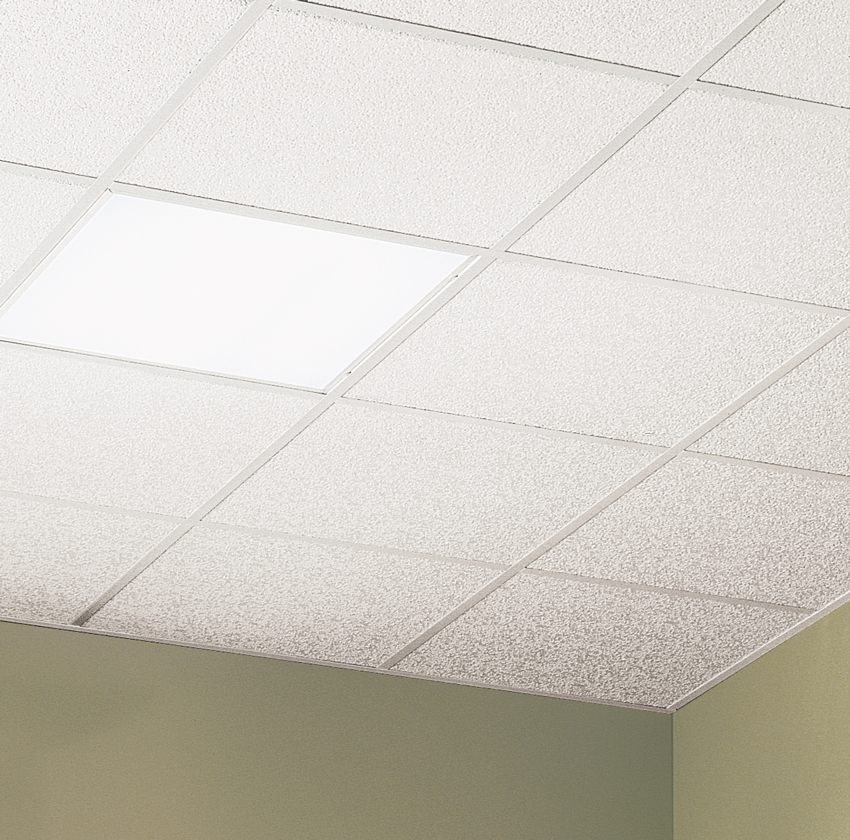
Photo courtesy of Armstrong Commercial Ceiling Solutions
Engineered seismic solution eliminates need for 2-inch wall molding
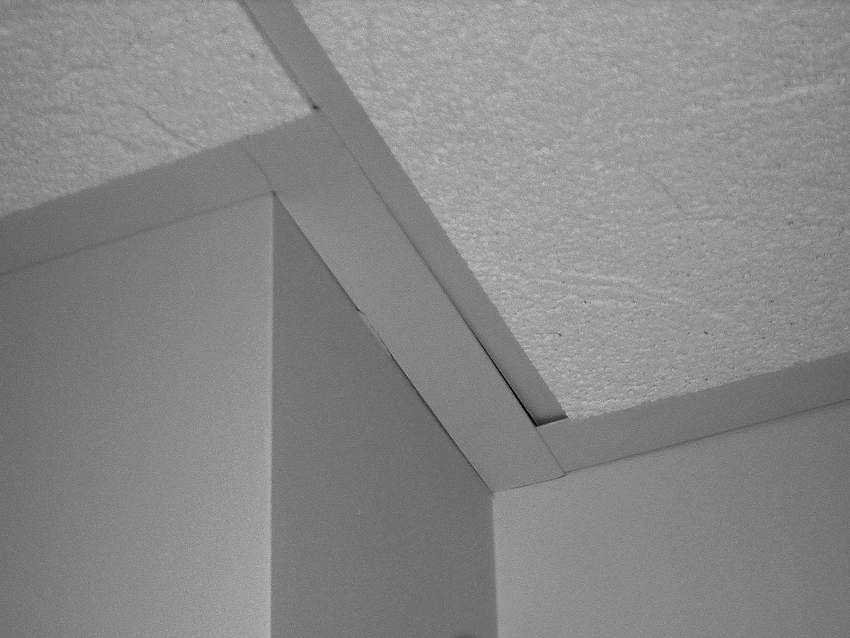
Photo courtesy of Armstrong Commercial Ceiling Solutions
2-inch wall molding required by IBC
Verifying that a ceiling is planned, drawn, created, and built precisely to specifications maintains the integrity of the entire system. If codes and requirements for a ceiling system are not discussed and planned for up front, not only will this delay construction schedules, but it could also lead to ceiling failure.
Acoustical Performance
As noted previously, complaints about noise and acoustical performance of a space are at the top of workplace gripes. To achieve comprehensive acoustic quality—an ideal combination of sound blocking and absorption of unwanted sound—acoustical ceiling products should perform at a high level according to two essential measurements: CAC and NRC.
Ceiling panels with high CAC and NRC ratings help block and absorb unwanted sound in open and closed office spaces that are used for both collaboration and focus work. These attributes are even more important in closed offices where privacy is key and sound could otherwise travel to adjoining spaces, such as other offices and corridors.
Failure to plan appropriately for sound or deciding to control for only one acoustic variable will spell dissatisfaction with the final built environment.
The decision to select a less-expensive product or traditional construction method that skimps on design control can mean owner dissatisfaction. Last-minute plan alterations typically add to the budget through increased labor and materials, and can make for an unsightly and inconsistent finish. Use of preconstruction services actually saves time and money for the project, particularly in designs calling for acoustical or drywall ceilings that require a unique solution or that call for special attention; with one-of-a-kind products; in custom applications; in new systems; in plans with complex geometries; and in systems with challenging transitions. By using detailed manufacturer shop drawings, specification sheets, and CAD/Revit drawings, you can easily create a perfectly finished ceiling using less time, labor, and material.
Code Compliance
Ceiling installation requirements follow the International Code Council’s International Building Code, or IBC. The IBC has been adopted by all 50 states. The code spells out the minimum performance standards for installation, acoustical standards, fire performance, and seismic restraint.
Code requirements continue to proliferate as higher-performance buildings with increased use flexibility are specified.
The important codes related to suspended acoustical or drywall ceilings include:
• C636/C635 M-13: Standard Practice for Installation of Metal Ceiling Suspension Systems
• E580/E580 M-14: Standard Practice for Installation of Metal Ceiling Suspension Systems in Areas Subject to Earthquake Ground Motions
• C645-14: Standard Specification for Nonstructural Steel Framing Members
• C754-15: Standard Specification for Installation of Steel Framing to Receive Screw-Attached Gypsum Panel Products
Code updates can spawn confusion over which new products or systems meet code requirements. If a product or installation does not meet the prescriptive requirements in the code, then an evaluation report may be required. To complete the evaluation, a manufacturer must submit product information and testing to independent evaluation agencies, like the ICC Evaluation Service (ICC-ES) and International Association of Plumbing and Mechanical Officials Uniform Evaluation Service (IAPMO ES). These evaluation services appraise the building products based on acceptance criteria. Products that meet the acceptance criteria receive an evaluation report stating that the product either complies with the code or is an alternate to what is specified in the code. Product reports are nationally recognized reports and are usually accepted by code officials to verify compliance.
As ceiling systems advance and buildings demand higher performance and in-depth certification, it is important to ask for and obtain reports from the manufacturer’s representative in the submittal process to ensure the products specified meet code requirements, both for IBC and ASTM.
Embracing the Latest in Ceiling System Innovation to Meet Client Needs
With innovations in pre-engineered ceiling systems, you can create high-performance, constructible ceiling designs faster and easier than ever before. For specifiers, pre-engineered component options and a broad variety of standard products with added capabilities and one-of-a-kind design support means design choices for every application, with assurance of quality and consistency. For the contractor, pre-engineered ceilings offer reduced labor and jobsite risk, and faster, more accurate installations.
Embracing the Latest in Innovation to Fully Realize Design Potential
Ceilings play a fundamental role in supporting a building’s design and purpose. Grid and framing systems form the backbone of the ceiling plane, and work in concert with panel materials not only to carry forward the aesthetics of a structure, but also to host a building’s vital mechanical, electrical, and support systems.
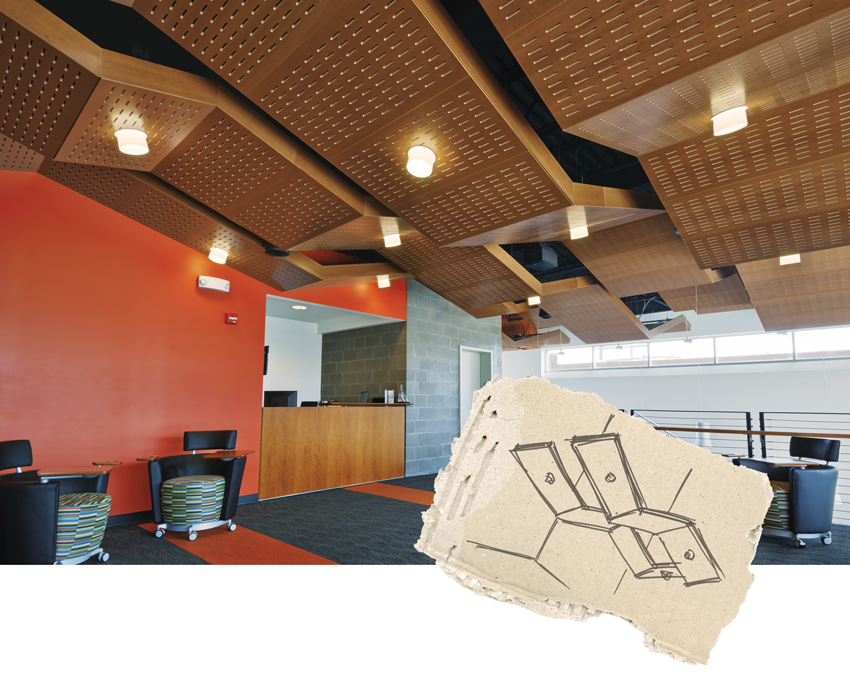
Photo courtesy of Armstrong Commercial Ceiling Solutions
Lyric Opera House Kansas City, Missouri HJM ARCHITECTS INC. Kansas City, Missouri Wood Panels hung on faceted suspension system
With the innovation and abilities of pre-engineered ceilings, creating high-performance, constructible, integrated systems is faster and easier than ever before.
For the architect, pre-engineered ceilings mean design choices for every application, but also provide the assurance that design aesthetics and acoustics are constructible, ensure enhanced installation quality and consistency, and lower project costs. The performance requirements of the space—aesthetics, environmental, durability, acoustics, seismic, recycling, light management, fire performance, humidity, durability, color, and codes/standards—are secured from the initial set of drawings to the final walk-through.
Pre-engineered ceiling solutions take on new importance, as traditional ceiling construction methods are no longer compatible with current design trends and today’s expedited construction schedules. Pre-engineering allows architects to win the challenge of designing spaces that use modern, best construction practices and that meet design intent, code requirements, and accelerated deadlines.
Amanda Voss, MPP, is an author, editor, and policy analyst. Writing for multiple publications, she also serves as the managing editor for Energy Design Update.

|
Armstrong Commercial Ceilings is the global leader in acoustical ceilings with the broadest portfolio of standard & custom metal and wood options available including clouds, canopies, baffles, and blades. www.armstrong.com/commceilingsna |

